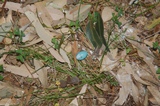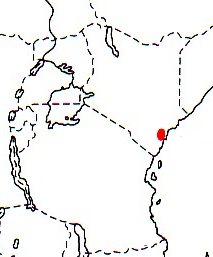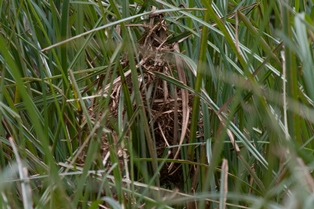Weaver species
Choose different species from drop-down list and press 'Go' button. See Full species list.Clarke's Weaver Ploceus golandi
IUCN: Endangered Discovery: 107Categories: wetland, fruit, IUCN,
News items about species
Discovery
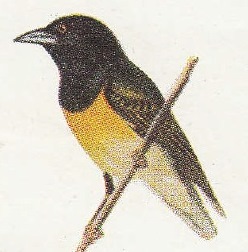
figure from Mackworth 1955a 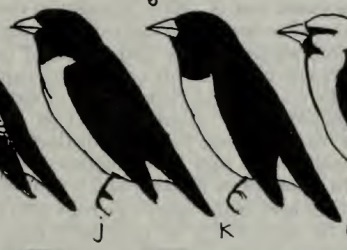
Clarke's Weaver (fig K), figure from Harrison 1965c 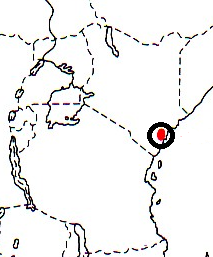
distribution, type locality circled IntroductionClarke's Weaver was formally described by Colonel Stephenson Robert Clarke, an English soldier and ornithologist.Clarke's Weaver was first collected by a native collector employed by Stephenson Robert Clarke and his younger brother Goland van Holt Clarke, an English soldier and naturalist. Stephenson Robert Clarke wrote several notes on birds, including the description of this weaver, which he named after his brother (the latter did not write any papers on birds). The Clarke brothers collected birds in various parts of Africa and the rest of the world. The Clarke brothers went on a shooting expedition to the Lorian Swamps in central east Kenya in 1912, where they collected many birds. They returned to Mombasa and from there sent a local collector to work along the coast as far as Lamu. The collector obtained several rare species, as well as a male Clarke's Weaver. The weaver type locality was listed as Mombasa, where the brothers were based at the time, but would have been collected in the Arabuko-Sokoke Forest. After the type specimen was collected in 1912, no more specimens were collected for 4 decades, so that Grant & Mackworth-Praed (1953) considered the type to be an aberrant, melanistic Lesser Masked Weaver. A second specimen was obtained in 1955 in the Sokoke Forest, however, by John Williams, after observing a flock and confirming it to be a valid species (Williams 1957b). In the late 1950s more specimens were obtained, including females. The Clarke's Weaver was first illustrated by Mackworth 1955a, showing the type male. The next illustration to be published was a line drawing by Harrison 1965c. Scientific citationHeterhyphantes golandi Clarke 1913a, Bull. Brit. Orn. Cl. 31: p.32, Mombasa, eastern Kenya Colony.Meaning of namesgolandi, Named after Captain Goland Clarke, one of the 2 brothers who first collected the species.First English nameCoast Black-flanked Weaver (Someren 1922a).Alternate namesCoast Black-flanked Weaver, Goland's Weaver.CollectorA native for Col. Stephenson Clarke and Goland Clarke.Date collected[Aug] 1912.Locality collectedAlong the coast between Mombasa and Lamu, Kenya.Type specimensThe type is in the British Museum of Natural History (BM 1913.1.17.1). |
The above is based on Weaver Wednesday 2, a weekly series about the discovery of each weaver species.
This species text first appeared as
Weaver Wednesday [224] - Discovery [107]: Clarke's Weaver on 2016-09-28
1. Basic biology

figure from Colin Jackson 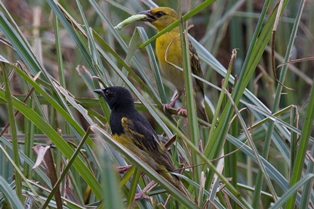
figure from Colin Jackson The female Dark-backed is like the male Dark-backed, while the female Clarke's Weaver is dull with streaked upperparts, yellow underparts, and yellow wing edgings.
Distribution.
Clarke's Weaver is found only in the Arabuko-Sokoke Forest and Dakatcha area in south-east Kenya (see map left, based on Birds of Africa). Its total range is 535 km Habitat. Clarke's Weaver inhabits coastal forest and is most frequent in miombo (Brachystegia) woodland; it needs wetlands for breeding and has also recently been found to roost in wetlands (Nature Kenya). Food. The diet of Clarke's Weaver is mainly insects such as beetles, caterpillars and scale insects; but it also feeds on fruits of Loranthus and Brachystegia spicifomis. Clarke's Weaver forages mostly in the canopy, in feeding flocks of up to 30, occasionally more than 100 individuals. It sometimes joins mixed-species flocks, especially helmet-shrikes (Prionops species). It may be found in single-sex flocks. At times it is conspicuous and gregarious, but flocks appear erratically. Other bird species apparently hawk insects that are flushed by the weavers, which are shy and restless.
Breeding. Nothing was known about breeding until an active colony was discovered in March 2013 (News). This date fits in with the suspected breeding season of February-March when the rains begin, since juveniles have been seen from March to August. It was a large colony, and Brian Finch estimated some five hundred nests concentrated in the small area of sedges (Nature Kenya). The monitoring team from Nature Kenya and the Dakatcha Woodland Conservation Group estimated that at least 700 birds were present. Adult weavers were bringing insects to the colony to feed nestlings (eg female in photo, top right). Nests were built of sedges, and the shape of the nests varied between rounded or oval, to more pouch-shaped Jackson 2015a). A second breeding colony was found in 2015 (News). Details of breeding (mating system, clutch size, egg colours and sizes, incubation and nestling periods, etc) are still unknown. Read more about the discovery of the colony here. |
The above is based on Weaver Wednesday, a weekly series about weaver species.
This species text first appeared as
Weaver Wednesday [62]: Clarke's Weaver on 2013-08-21
2. Breeding facts
| Pair bond No information Breeding season Juveniles recorded in Apr and Jul-Aug, and male in breeding condition in Sept Nest site No information; It is speculated that nests may be high in trees Nest building No information Colony size No information Clutch size No information Egg colour No information Egg size No information Incubation No information Chicks and nestling period No information |
Breeding information based on Handbook of the Birds of the World, Vol. 15.
3. Photos of Weaver Nests
 Vm 28236 |  Vm 27552 |  Vm 20379 |  Vm 5624 |
Thumb-nails of most recent PHOWN records - click on one to see its full record
See all PHOWN records for this species here.
PHOWN (Photos of Weaver Nests) provides valuable info on breeding distribution and colony sizes of weavers.
You can contribute by registering and submitting photos at Virtual Museum webpage.
4. Breeding distribution
Google map showing distribution (For species with small ranges you need to zoom in at the correct area to see the range):
yellow blob - range of weaver species; read more about this here.
![]() - PHOWN records with photos
- PHOWN records with photos
![]() - PHOWN records with no photos (Nest Record Cards, other records)
- PHOWN records with no photos (Nest Record Cards, other records)
![]() - Birdpix records
- Birdpix records
![]() - comments on out of range records, or interesting records
- comments on out of range records, or interesting records
![]() - type locality
- type locality
CLICK on the marker on the map to see individual record details.
5. Range changes
Not South African speciesThe above is based on Weaver Wednesday 3, a weekly series about range changes in South African weaver species.
This species text first appeared as
n/a








